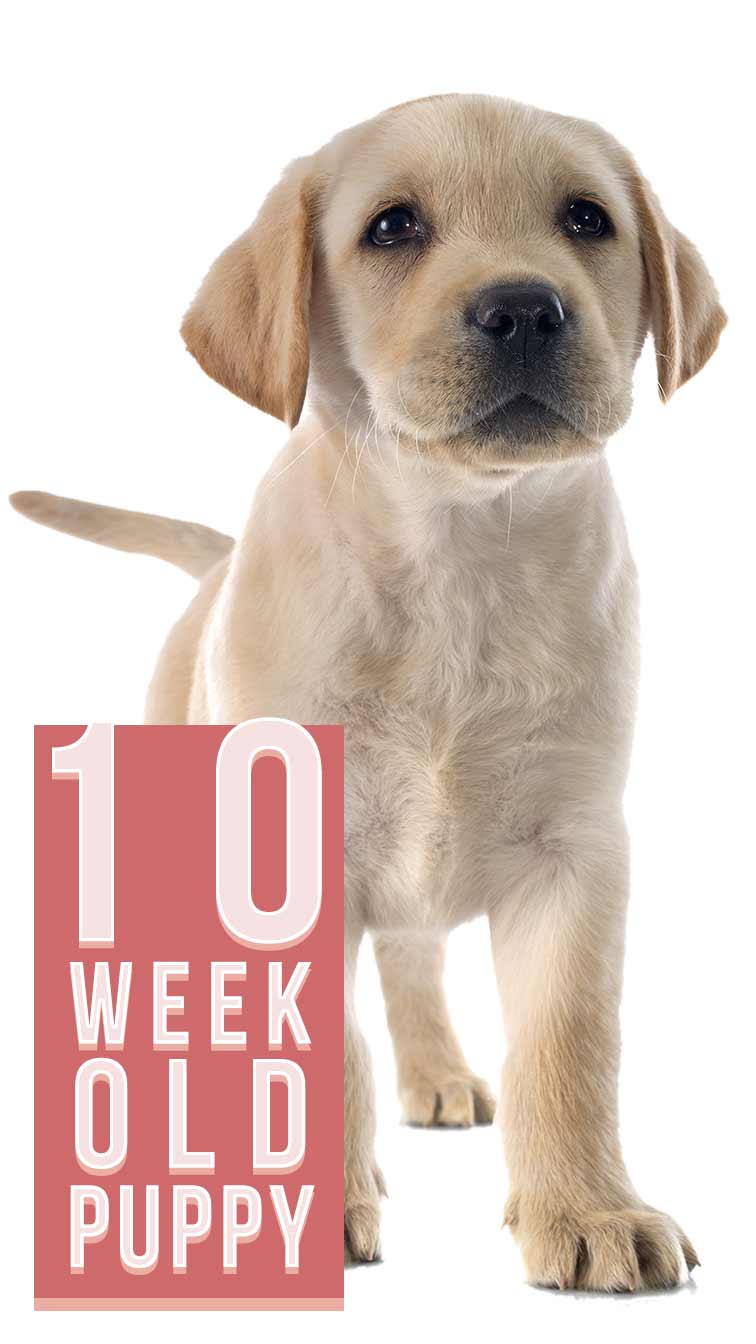10 week old puppies have a lot of things in common with each other. They all need frequent meals and bathroom breaks, lots of play and nap time, plenty of socialization, and opportunities to chew and chomp that preferable don’t include your fingers and clothes. I remember my puppy hitting ten weeks as though it was yesterday. A fabulously fun age, but one that raises a few concerns and stresses too.
This is your complete guide to living with a 10 week old puppy. I’ll walk you through what to expect from a pup at this stage, and how to help ease them into your life. You’ll also get a great 10 week old puppy schedule, along with loads of fabulous tips to help you stay on track with them. And some much needed advice for those parents dealing with the puppy blues!
- Daily routines and socialization
- Your new life together
- Getting used to spending time alone
- Training through play
Your 10 week old puppy schedule
This is our usual 10 week old puppy schedule, which should make a nice basis for your own. Remember, the timings will vary depending upon your own routine as well as other factors, like the size of your puppy’s bladder!
- 6 am Potty break
- 7 am Meal then potty break
- 9 am Potty break
- 11 am Meal then potty break
- 1 pm Potty break
- 3 pm Meal then potty break
- 5 pm Potty break
- 7 pm Meal then potty break
- 9 pm Take water up
- 10pm Potty break
- Midnight Potty break then straight to bed
What to expect from a 10 week old puppy
You can expect your new puppy to:
- Pee at least every two hours
- Want to spend all their time together
- Nap frequently
- Be very playful
- Use random items in your house as chew toys
But you probably had a lot of different expectations for the past two weeks, which didn’t come to fruition. And these can feel like a really big deal in the early days.
When puppy blues sets in…
No matter how much you prepare for the arrival of a new puppy, the reality can come as something of a shock. Potty training accidents happen despite our best efforts. Night times are interrupted, and apparently over for good by 6am. Over-excited puppies launch themselves relentlessly at clothes and skin with razor sharp teeth. And all the nice things you used to be able to do outside the home suddenly seem far, far out of reach.

Even experienced puppy parents aren’t immune. Every puppy is different, some are simply harder than others. It’s enough to leave us over-tired, wrung out, and deflated. What if it was all a massive mistake? The good news is these feelings of puppy blues are completely normal.
How To Cope
Many puppy owners go through exactly the same emotions when they bring home a new puppy, and survive to reassure others about it from the other side. Talking helps, so tell a friend with dogs in real life how you’re feeling. Or, visit our forum where you can read dozens of stories from happy dog owners who also experienced that period of overwhelming doubt. And importantly for you and your pup, make sure you look for safe ways to get out of the house together.
Socializing a 10 week old puppy
At 10 weeks old, your puppy is right in the middle of the all-important socialization window. The socialization window is an important period of puppy development. It’s when they’re most receptive to new experiences, and likely to form positive associations which last a lifetime. It opens at three or four weeks old. It again closes between 12 and 20 weeks old, but on average by about 16 weeks old.
Quality Over Quantity
Ten week old puppies still get tired quickly, especially after taking in lots of new sensory information. And to be honest, a 10 week old Lab is already getting a bit heavy to carry for long periods. So these socialization outings are only going to be short and sweet.
The trick is to make sure your puppy has a wonderful time seeing something new. Don’t keep going until they’re bored, frustrated, overwhelmed or uncomfortable. Leave on a high!
Here’s How To Do It
Pop your puppy’s next meal into a resealable bag or tub. Carry or drive them to somewhere they’ve never seen, heard or smelled before. Then feed them their meal, one piece at time while they sit on your lap (or by your side in the trunk of the car) and watch the world go by. Great places to go include:
- a bench on a sidewalk with lots of pedestrians
- anywhere you can comfortably settle for five minutes by a busy road
- the parking lot at the beginning of a hiking trail (you’ll see lots of other dogs from a safe distance here!)
- dog friendly cafes, bars and restaurants
For bonus points, try to feed your puppy the moment something (a vehicle, or another dog for example) catches their attention, but before they can react by barking or trying to move towards it. In an ideal world the majority of your puppy’s kibble will be used in training, not given in a bowl. This builds up positive associations for your puppy. And also lays the groundwork of looking to you for cues about what to do next.
Getting Used To Being Touched
Socialization isn’t just about visiting new places. Brushing, bathing, nail clipping, teeth cleaning and veterinary exams are all inevitable parts of a dog’s life. Socializing your 10 week old puppy to accept these experiences confidently is something you can work on in the safety of your own home. But don’t try to give your puppy a full pedicure on your first attempt.
Start by putting the nail clippers in a work surface in sight of him and feed a small handful of treats. That’s day one done! The next day, hold the clippers in one hand whilst treating from the other. Day two done! On day three, have someone else dispense the treats while you hold the clippers in one hand and gently lift one paw with the other. When it comes to socializing for grooming experiences, the slower you go, the faster you’ll get there!
Don’t Feel Overwhelmed!
The list of things to socialize your puppy to, and the fear of unintended consequences if you get it ‘wrong’ can be overwhelming. But every bit of effort you make is a fantastic investment in your puppy’s future.
Research shows that puppies socialized to different places and physical examinations during puppyhood are less likely to be given up by their owners. Most of the things you can do take less than half an hour. So even if you aim for just a couple of new experiences a day, and you’ll be amazed how quickly they add up. And getting your puppy used to daily life doesn’t just involve being together. Sometimes it needs to be about spending time by themselves too.
Spending time alone!
It’s still going to be several weeks before you can leave a 10 week old puppy at home while you go out for the morning. If you haven’t already begun crate training, it’s not too late to start. If you’re not using a crate, you’re still going to need a safe, secure area in your home where your puppy can be left for short periods as they get older. This could be a playpen, or a whole room, with a comfy bed in it.
Now is the time to make sure this space is always a happy and comforting place to be. Frequently drop a couple of treats into the bed while your puppy isn’t looking. You should find that by 9 to 10 weeks old they regularly take themselves back there to rest and nap. The good news is that most puppies settle comfortably into a routine of being left for short periods from this age. And in the absence of anyone to play with, they usually just take the opportunity to have a nap!
Games and training
When your puppy isn’t on their own, they will need lots of time and interaction from you. Right now, your 10 week old puppy’s mind is like a sponge. And their appetite for fun and games is insatiable!
Playing with your puppy is a wonderful way to start forging a bond which places you at the center of their world. And playing with them the right way means you can already start teaching good manners, without them even realising it was a lesson! This article about how to play with your puppy will set you off on the right foot.
Potty training problems
Potty training starts from the moment you arrive home with your puppy. But finishing it can take several weeks!
Hopefully by the time they’re 10 weeks old, you can recognise some of the signs that your puppy needs to go out and pee or poop. They might be going a little longer between toilet trips too. But don’t get complacent – keep taking them out regularly.
When accidents do happen, clean them up thoroughly with a little dilute biological detergent, or a specialized enzyme cleaner. Puppies love to pee where they’ve peed before, so don’t leave them any clues! If you feel like you’re not making the potty training progress you’d hoped for at this stage, check out our trouble shooting guide now.
How Is Your 10 Week Old Puppy Getting On?
When your puppy reaches 10 weeks old, you’re likely to really be in the thick of it, and wondering what you’ve taken on. But it’s also the cusp of a tipping point for many puppy parents.
In the next couple of weeks, your puppy will be ready to go for walks outdoors. And all the effort you’ve put into settling them in and potty training will start to pay off. Just hang in there, share your progress, and ask any questions you have over on our forum.
The Labrador Site Founder
Pippa Mattinson is the best selling author of The Happy Puppy Handbook, the Labrador Handbook, Choosing The Perfect Puppy, and Total Recall.
She is also the founder of the Gundog Trust and the Dogsnet Online Training Program
Pippa's online training courses were launched in 2019 and you can find the latest course dates on the Dogsnet website



















